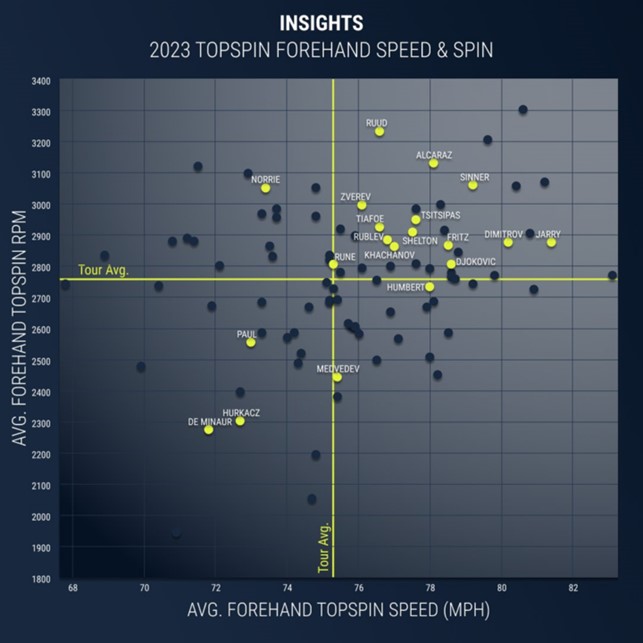“When power tennis meets control: the explosive forehand of the young Frenchman Arthur Fils ready to shake up the circuit. Was Tokyo just the beginning?”
For those who may not remember, “power is nothing without control” we are referencing to an iconic advertisement claim by Pirelli featuring Ronaldo the phenomenon.

Why mention this not-so-obvious quote? Because it fits perfectly with Arthur Fils and his often uncompromising power tennis. The young Frenchman, just in his twenties, obviously has plenty of time to learn how to temper his exuberance, and when he does, it could spell trouble for his opponents, as seen at the Tokyo tournament these days. His exploits have given us an excuse to delve deeper into the Frenchman’s game, particularly his forehand, which is truly his trademark. To do this, we’ve relied, as usual, on data from Tennis Insights which, since the end of last year, provides new statistical measures for ATP 500 and 1000 tournaments.
Remember, the quality of the forehand (Forehand Quality) is a synthetic indicator expressed on a scale from 0 to 10, (somewhat like old school grades). This data is generated by artificial intelligence analyzing speed, spin, depth, and angle. A high score can be achieved with very different shots; for example, a fast, flat forehand can be just as effective as a deeper, more topspin-laden ball.
Seeing that in Tokyo Fils managed to average forehands with a score of 9 is a sign of how effective he has been this week in Japan. To give an idea, we’ve retrieved some statistics that post-US Open gave us a measure of how the best have hit the forehand in 2024.

The names that appear are known and expected, but that’s not what interests us. The point we want to emphasize instead is that the best of 2024 have had a forehand performance, the shot that ultimately tips the scales in most cases, inferior to the peak recorded these days by Fils. First takeaway of the day: Fils often goes overboard, but when he fires the cannon, he could become that unpredictable variable that in the best years was Stan the Man Wawrinka.
Now let’s take a closer look at what makes Fils’s forehand so extraordinary.

In this graphic, always published on Tennis_Insights, we see a recap of the year 2023 regarding the two main physics of the forehand, speed (speed) and spin (topspin). It’s no surprise to see Sinner and Alcaraz at the top right. However, there is a dot that leaves the rest of the group behind; in statistics, this would be called an outlier, or a data or observation that significantly deviates from the other data in a set. In other words, it is an anomalous value that does not follow the general pattern or trend of the other data.
Try to guess who it is, and once you have an idea you can move on to the following graphic.

Well, as you can see, in addition to moving in terms of speed well above average, Fils’s shot is also infused with a deadly amount of spin, making it a constant threat to his opponents. Second takeaway, the physics of Fils’s shot is deadly. The problem is that in tennis, however, you play on a court delimited by lines and with a net in the middle.
Let’s then see why in Tokyo Fils’s forehand was not just a crazed ball cannon but a phenomenal shot that annihilated his opponents.
• First of all, as we can see, the shot simply stayed more in court: if normally opponents could count on the fact that Fils’s forehand would sooner or later go haywire in Japan, it was not so; in fact, the Frenchman proved more consistent than the ATP average.
• In terms of the physics of the shot, Arthur has further raised the bar both in terms of speed and spin, seasoned with an even higher predisposition to risk. If the average of his ATP 500 and 1000 circuit peers (so we’re not considering weak players), sends 27% of shots within a zone that is a meter from the lines, Fils has produced a whopping 35%, a percentage difference that at these levels is almost enormous.
• The impact analysis finally shows a very clear tactical story: when Fils could move from the backhand side to play the unconventional forehand (inside in or inside out), he was simply devastating. The metric reads like this: when Fils played the unconventional forehand, in 37% of the cases that shot produced a winner, an opponent’s error, or a situation of control in the exchange.
In conclusion, Arthur Fils demonstrated in Tokyo just how devastating he can be when he manages to combine his extraordinary power with greater control. His forehand, already recognized as one of the most lethal on the circuit, has reached levels of effectiveness that highlight a potential that could propel him among the greats of world tennis. There are good reasons to think that Tokyo was just a one-off exploit, but just as many to think that it was not. On one hand, in many respects (speed, spin, placement) Fils played an extreme kind of tennis with little margin for error, pushing to the limit.
On the other hand, it is undeniable how simply devastating he was when his opponent failed to pin him down on the backhand side; only time will tell if Arthur will manage to mask his weaknesses, but given his young age, we must at least give him some credit. If Fils can maintain this consistency and manage his exuberance well, the Frenchman could become that “dark horse” capable of destabilizing any opponent, just as Stan Wawrinka did in his time. The future is in his hands, and we look forward to witnessing the next chapters of this promising career.






